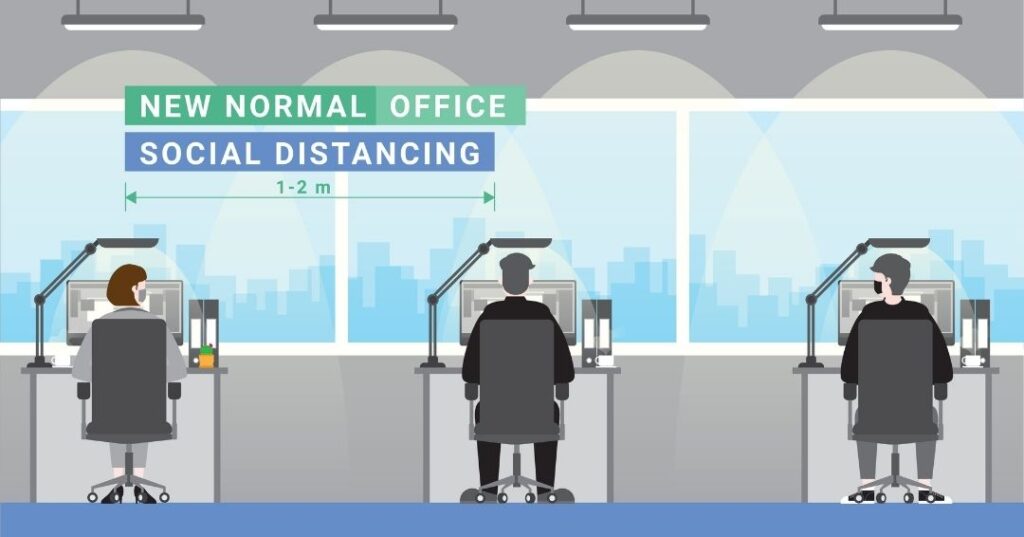
With the Prime Minister vowing ‘no more lockdowns’, bringing back current team members and onboarding new employees – all in a new and socially distanced setting – is the aim of many organisations this year.
Covid restrictions are now thankfully a thing of the past, as chief medical officer Chris Whitty stated in a government briefing in April 2021 that we have finally reached the point where coronavirus will “be treated like the flu”.
It might feel like we have been at this point before, but now we are faced with the actual event. Organisations keen to physically re-start their business, employees looking to get ‘back to normal’ – 2021 is the year of the grand re-opening.
While this will be an exciting and pivotal moment for your business, there is a lot to consider first.
Many individuals have been conditioned to the lockdown lifestyle. Getting back to work will require a total mindset shift, not to mention the physical and logistical arrangements you will need to work out.
In this guide, we simplify getting your personnel back to work after a year of lockdowns in their many forms.
Ready to re-open? Let’s get started.
Rachel Pedrithes
Founder & Director Ice Recruitment Ltd

Making Sure People are Safe
Firstly, you must ensure that your team, any visitors and customers or clients who may be visiting the workplace, are Covid-safe.
The virus hasn’t gone away, and as we know, this type of disease is subject to mutations and changes, so people and their safety must come first.
What safety measures do you have in place currently? If these were first introduced last year, it might be time for a total re-evaluation of your safety strategy. Complete a risk assessment for your workplace, bearing in mind that this needs to be a longer-term plan than perhaps you had in place previously.
Think about:
- Do you have in place a strategy for suppliers of PPE, sanitising equipment?
- Are you operating a one-way system?
- What does social distancing look like in your workplace?
- Do your employees have enough space between workstations?
- Have you organised a deep clean of your business premises before you bring people back?
The government are continually updating their Covid workplace guidelines – and you can read the latest version by clicking here.
When completing your risk assessment, it is good to consult your employees, as this will ease some of the anxieties they may have about returning to the workplace. Consider a return-to-work meeting to discuss any issues your team may have around returning to the workplace.
Some individuals have been looking forward to returning to work, whereas others might be more reluctant. Supporting your team with their choices is critical to help them feel supported and to keep morale high during what could be a strange time.
Meetings, for now, are being mainly conducted virtually, but if there is the need for any employees to have face-to-face meetings with customers or clients, you will need a Covid-safe procedure for this too.
Planning for the Reintegration of Your Team
Depending on your organisation’s size and scale, there will need to be a plan in place before your employees can return to the workplace.
Even for smaller teams, organising a complete return to work can be a logistical challenge.
Think about the following –
- Will management be returning before standard employees?
- If individuals are bringing equipment back, do they need help?
- Will the return dates and time be staggered, on different days or in specific groups?
- Are there any clinically vulnerable employees who need extra safety measures?
Remember that any clinically vulnerable employees should be supported where possible to continue to work from home and have the right to refuse to return to the workplace if they believe that it would be a danger to their health.
When you finalise your plan, ensure it is clear, concise, and communicated to your team.
For a range of organisations, this year will be the first where some teams become separated between people who return to the office and those who continue to work from home. Remote working has exploded since the start of the pandemic, and it has been a divisive issue. Remember to support your remote employees even as your ‘physical’ team returns.
Some employees will not have their preference met, and there may be feelings of mistrust or even jealously between office and home-based colleagues.
Your Team’s Wellbeing
After the initial return to the office, longer-term, you will need to implement a physical and mental health strategy to continue to support employees.
The pandemic has taken its toll on the nation’s mental health. Bereavement, isolation, fear, and loss of income have created and exacerbated many mental health conditions.
Over half of all adults have reported their mental health suffering due to the pandemic, according to recent findings by mental health charity Mind.
The government have stated that social distancing could be in place for years to come. If social distancing continues in the workplace, this might potentially negatively affect your team’s wellbeing. As social interactions will be limited – even being in the workplace and surrounded by people can feel like a lonely place.
A wellbeing pledge is something that people increasingly look for in a employer. In the wake of the pandemic, it is more important than ever to look after your employees’ wellbeing.
You can support employee mental health with the following:
- Offer benefits to support good mental health, such as a wellbeing portal for employees to access.
- Educate your team on financial matters – mental health issues can be eased when money worries are taken care of; could you offer budgeting help or childcare vouchers?
- Create a culture where staff look after each other – a toxic work environment is one of the fastest ways to deteriorating mental health. Have a zero-tolerance policy for bullying and misconduct, ensure leaders and managers are operating in a fair way that motivates rather than belittles staff.
Check in with your team regularly and be aware of the signs of deteriorating mental health, such as poor performance, taking time off and appearance of low mood. Connect with remote employees via Zoom – make time for everyone during these critical first few months back.
Re-communicating Your Vision
Your company’s vision and mission are crucial in times of crisis. You must fill returning employees with confidence that the business and their role is stable, even if the company as they once knew it has changed.
After such a significant upheaval to your business, your team should be privy to a review of the company mission upon returning.
It may be that your company mission has not changed or has only changed slightly – you should still communicate this with employees. Their lives may have changed in other significant ways; they need to feel they are returning to a solid and stable working environment.
If your business, or parts of it, have changed dramatically due to Covid, be confident when informing employees of new changes. Change can be unsettling, and this can be neutralised with clear, confident communication.
No one has a crystal ball, but what employees will be looking for from leaders is a directive that the company is capable and resilient enough to get through whatever happens.
Have you had a review of your business vision and mission? Some things to consider:
- Take the time to envisage your company’s future – HBR suggests spending 10 – 20 per cent of your time each week dedicated to thinking about your business’ future aspirations for the post-Covid world.
- Take your end goal and walk backwards from it – reverse engineer your ultimate business plan, as this will force you to think with clarity about what needs to happen and when. It will also help you realise which investments should be given priority, such as recruitment, sales and marketing campaigns or expansion plans.
- Be prepared to flex – The key to a successful post-Covid business plan is one that you can pivot on if needed. In the early stages of your team returning to the office, there will be parts of your vision that may need ironing out – accepting this is key to success.
A change to your company vision will need robust backing by all management and senior leaders – make sure you can rely on all required staff to be on board with company changes.
Rebuilding Team Culture
A significant part of your team culture will likely have relied on the physical interactions between employees – this is something that businesses didn’t realise before the pandemic.
None of us expected to have our physical exchanges limited as we have. Now is the time to think about how this could have damaged your organisational culture, especially if some of your team work remotely; the dynamics will now be completely different.
There might be new employees, previous teams may have disbanded, there will be a different culture now – and as a leader, you must hone and cultivate a positive culture.
Protecting your people will be the first step to cultivating a positive culture. A big part of what makes happy teams is employees knowing they are supported by management.
Then think about what you can do to create the sense of camaraderie that contributes to team culture. Zoom quizzes or meet-ups, which have been widespread, continue to be a hit with many businesses as they are a great way of getting everyone together regardless of distance.
Upskilling
The team that returns to your business may not be the same one that left last year.
There might have been redundancies, people may have moved on, and you could even have employees who have been recruited and onboarded remotely.
Some individuals may have been undertaking training while on furlough or working from home, but for the most part, there will likely be a need to assess where the skills gaps are and put in place a plan to start upskilling your returning team members.
You could require new skills in your business due to the pandemic. There might even be the need to create new roles, new management positions, or new teams entirely.
What internal or external training can you provide? Training can be something that slips down a leader’s list of priorities, but it will be vital to your post-Covid recovery.
At the 2021 World Economic Forum’s Davos Agenda, upskilling was hailed as the key to a robust recovery from the pandemic. During the event, PwC released a report entitled Upskilling for Shared Prosperity. The report states, “upskilling the global workforce is key to stimulating the economic recovery from COVID-19.”
The report notes that a change is coming from the pandemic and that focusing on improving your workforce’s skills will be critical to business success.
So, what skills should you look to develop in your employees?
A recent McKinsey report identified four key skills required for the post-Covid market, they are:
- Digital skills
- Cognitive skills – ready for redesign and to embrace innovation
- Social and emotional skills
- Adaptability and resilience
As you can see, there are soft and hard skills to develop within your team. The future is still relatively uncertain; you need an emotionally intelligent, resilient workforce ready and capable of solving new challenges and driving your business forwards.
The Financial Health of Your Organisation
We’re now in the second year of the ‘Covid crisis’, and although public health is still the number one concern, your business’s financial health is something you must consider as employees return to the office.
Financial planning for the future in our post-Covid world requires an intelligent, systematic approach. Depending on the size of your organisation, you might not have a dedicated in-house financial specialist. Still, even if you don’t, as a business owner, you must be aware of how to quickly make the most of emerging opportunities and be agile with your forward planning.
Your team returning could also be the catalyst for a change to your workspace. Is your current office financially viable, or do you now have considerably fewer office-based employees?
Now could be the perfect opportunity to reduce your expenditure on office space – many businesses have dramatically reduced or altered their offices. Your team might have been reduced by a significant amount – can you think about taking on a smaller office?
Have you been waiting until the team is back in the office and ‘back to normal’ before making some critical choices about your businesses future? Now is the time to make these vital decisions.
Your Business Growth Plan
Some businesses have been holding off revising their business plans or making new ones as markets continued to shift.
Now, we are in a position where we can realistically start planning for the future – and this means revisiting your business growth plan.
There are a couple of things to consider when creating a post-Covid growth plan for your business:
- How does your business make money? This might have changed recently. Have you got a handle on all current and future products and services?
- Which key players drive the business? Outline your critical staff and key stakeholders.
- How has the pandemic affected your customer’s behaviour, and do you need to make changes to your business plan or staffing arrangements to meet these criteria?
There may be new motivators driving your products and services, new behaviours in your customer or client base that requires a new business plan.
Now is the time to look critically at what is working in your business and what isn’t and to create an intelligent business plan going forwards.
Additionally, think about the nature of your business and if it has changed since your team were last in the workplace.
If you are now planning new niches or expanding different parts of the business, how will this work long-term? Have employees been taking on duties outside of their current role – and if so, do you need a different working set-up to allow your team to grow into new roles or responsibilities?
This ties into the physical set-up and the financial health of your team too. For some businesses, the returning employees might be made up of the same members. Still, their roles and immediate colleagues may have changed – do you need to provide a different working set-up to help drive any changes you have made?
Plans for Talent Growth
Upon returning, it might become apparent that you need to revise your talent growth strategy for the future.
Despite the rise of remote working, depending on the size and level of your ‘physical’ team, the return to the workplace could be the catalyst to realise you need to expand.
We mentioned upskilling, but there may be gaps in your team now where only a new employee will suffice.
Recruitment will play a significant part in your business in this period of recovery. At some point, you will need to hire new staff for your business which will have, at every level, been changed by the pandemic.
Recruiting in a changed landscape might be difficult – and that’s where we can help.
We have been recruiting professionals for over 13 years and are the first choice for many organisations (take a look at us) when they need critical staff, but they aren’t sure exactly the talent they need or how to find it.
With our extensive network of technology sales talent, we can help find you the recruits you need, from a single hire to a new department.
Get in touch with me today on 01707 841634 or contact me here rachel@ice-recruitment.com or visit our website www.ice-recruitment.com to find out more about how our recruitment service can help you build and develop your team.







